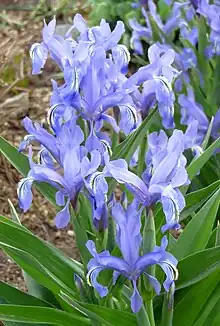Iris graeberiana
Iris graeberiana is a species in the genus Iris, in the subgenus of Scorpiris. It is a bulbous perennial.
| Iris graeberiana | |
|---|---|
 | |
| Scientific classification | |
| Kingdom: | Plantae |
| Clade: | Tracheophytes |
| Clade: | Angiosperms |
| Clade: | Monocots |
| Order: | Asparagales |
| Family: | Iridaceae |
| Genus: | Iris |
| Subgenus: | Iris subg. Scorpiris |
| Section: | Iris sect. Scorpiris |
| Species: | I. graeberiana |
| Binomial name | |
| Iris graeberiana | |
| Synonyms[1] | |
| |
Description
In late spring,[2] (or April),[3] it has between 4–6 flowers per stem and reaches a maximum height of 45 cm (18 in) tall.[4]
It has pale silvery mauve flowers.[4] It also comes in blueish-lavender,[2] or blue-violet shades.[5] The flowers are 6–8 cm (2–3 in) wide with a wavy,[5] white crest on each fall.[2] Which is surrounded by a pale, boldly veined zone.[5]
The white margined leaves, have glossy mid-green tops, but with greyish green bottoms, which are scattered along the stem.[2] The leaves grow to approximately 20 cm (8 in) tall at flowering time, then they extend to twice this. They are between 1.5–3.5 cm (1–1 in) wide.[5]
Taxonomy
It was named after Paul Graeber (a plant collector who also collected Iris hoogiana and Tulipa ostrowskiana for the Dutch Van Tubergen company).[6][7]
It was first published in Botanical Magazine Vol.167 on table 126 by Sealy in 1950.[8]
Iris graeberiana is an accepted name by the RHS,[9] and the iris is recognized by the United States Department of Agriculture and the Agricultural Research Service, since 2003.[10]
Distribution and habitat
It is native to Tajikistan,[11] and Turkestan (parts of the former republic of USSR) in Central Asia.[4]
Cultivation
It is known as one of the more vigorous species,[4] therefore is easier to grow the others in the subgenus.[2] It is also hardy to USDA Zone 5–8.[12]
They are best grown in well-drained soils [13] in open, stony places or an Alpine house, but some growers recommend outside culture, if sheltered from heavy summer rains.[5] The plant attracts birds and butterflies.[14]
It can be seen growing in Le Grand Clos botanical garden in Bourgueil, France.[15]
Known hybrids
It is thought to have been bred by crossing Iris graeberiana with Iris magnifica.[12]
- Iris graeberiana 'Yellow fall',[17]
- Iris graeberiana 'Dark Form' ; a more hardy plant but with smaller darker flowers. It is similar to Iris zenaidae but with smaller flowers.[18]
References
- "Juno graeberiana". www.theplantlist.org. 23 March 2012. Retrieved 21 August 2014.
- Brickell, Christopher, ed. (1996). RHS Encyclopedia of Garden Plants. London: Dorling Kindersley. p. 522. ISBN 978-0-7513-0436-7.
- "How to grow Iris". www.backyardgardener.com. Retrieved 23 August 2014.
- Cassidy, G.E.; Linnegar, S. (1987). Growing Irises (Revised ed.). Bromley: Christopher Helm. pp. 145–146. ISBN 0-88192-089-4.
- "Iris graeberiana". encyclopaedia.alpinegardensociety.net. Retrieved 23 August 2014.
- Austin, Claire (2005). Irises: A Gardener's Encyclopedia. Timber Press, Incorporated. ISBN 978-0881927306. OL 8176432M.
- "Tulipa ostrowskiana". rareplants.co.uk. Retrieved 23 August 2014.
- "Iris graeberiana". apps.kew.org. Retrieved 21 August 2014.
- "Iris graeberiana". www.rhs.org.uk. Retrieved 21 August 2014.
- "Taxon: Iris graeberiana Tubergen ex Sealy". npgsweb.ars-grin.gov. Retrieved 8 January 2022.
- "Tajikistan". lntreasures.com. Retrieved 23 August 2014.
- "Iris graeberiana". www.signa.org (Species Iris Group of North America). Retrieved 23 August 2014.
- "flag". Retrieved 23 August 2014.
- "Iris graeberiana 'White Fall' | Chicago Botanic Garden". www.chicagobotanic.org. Retrieved 2022-01-08.
- "irisbotanique".
- "Autumn List (G-L)". www.westonbirtplants.co.uk. 2007. Retrieved 19 August 2014.
- "PlantFiles: Juno, Scorpiris". Retrieved 23 August 2014.
- "Juno Irises (A-l)". www.pacificbulbsociety.org. Retrieved 23 August 2014.
Other sources
- S. K. Czerepanov, 1995. Vascular plants of Russia and adjacent states (the former USSR) Cambridge University Press. (note: listed as Iris graberana Sealy)
- Walter Erhardt, Erich Götz, Nils Bödeker, Siegmund Seybold: Der große Zander. Eugen Ulmer KG, Stuttgart 2008, ISBN 978-3-8001-5406-7. (Ger.)
- Brian Mathew, 1981. Iris,
 Media related to Iris graeberiana at Wikimedia Commons
Media related to Iris graeberiana at Wikimedia Commons Data related to Iris graeberiana at Wikispecies
Data related to Iris graeberiana at Wikispecies